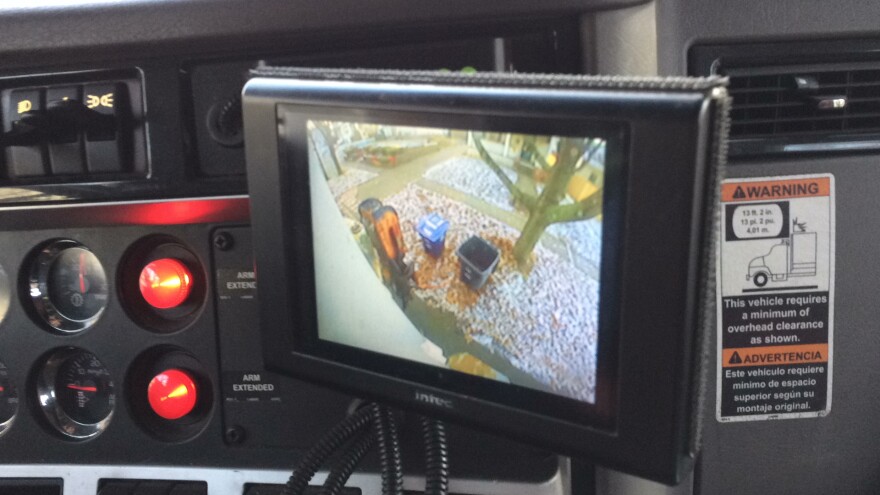When it comes to recycling plastic, most people check for a number on the bottom of every container. But what does that number actually mean, and why are some plastics not recyclable? This installment of our series, Reduce, Reuse, Refocus traces the life cycle of a piece of plastic.
Near the beginning of the 1967 film “The Graduate,” there’s a well-known exchange in which Dustin Hoffman’s character – a recent college graduate – is given some advice by a family friend.
“I just want to say just one word to you. Are you listening? Plastics.”
In the five decades since, people like Meredith Ersing have thought about plastics – starting at the supermarket. The teacher from Stow hits her local Giant Eagle each week, trying to buy items that come in recyclable packaging. But it’s not always easy when she’s shopping for herself, her husband and a toddler who loves berries.
“The clamshells? These are always a pain if we’re talking recycling. I don’t even know if there’s a number on these. Oh, it’s a 1.”
The clamshells that most berries are sold in aren’t recyclable. So she wants to know: which plastics actually are recyclable based on that little number on the bottom?
“When I’ve read about it, it seems like Numbers 1 and 2 are generally accepted. But I’m not sure if I throw a #5 in there, what really happens?”
By the numbers
James Eagan, a professor of polymer science at the University of Akron, said, “That triangle is one

of the most misleading symbols that we have. That is the resin identification code. Not all of those mean that they can be recycled. Those numbers are telling us things about the chemical structure.”
Plastics numbers 1 and 2 are easily recycled by most municipalities. But Eagan said 3 and 6 – polystyrene and PVC or vinyl and Styrofoam – “are challenging because they can release toxic chemicals.”
As for the others, Number 5 are heat-resistant plastics and 4 are plastic bags and wraps that need to be kept out of single-stream recycling. Finally, number 7 is essentially a smorgasbord of everything else – some of which can’t be recycled, depending on where you live. In Akron, they accept bottles with a 7.

Tuning in for trash day
They’re collected by people like Marty Shaffer, who gets up at 4 a.m. each day to drive a recycling truck. He extends a large claw from the truck to grab the blue bins that, hopefully, contain a pile of recyclables. He monitors the action on a small, dash-mounted color TV.
“As it dumps, I can see it going in the hopper. So if it’s nonrecyclable, I usually write it down and turn it in to the boss and they’ll tag the can and warn the people.”
That’s the chain of enforcement that could lead to repeat offenders losing their recycling bins. But Shaffer says it’s happening less frequently. Ideally, some day he hopes to end his shift at Akron’s Material Recovery Facility (MRF) by dumping a full truck with up to six tons of actual recyclables.
Meet the MRF
Betty Trimper runs the MRF, which is near the Goodyear Airdock. Her team separates out any large objects or obvious hazards like car batteries. And then, technology takes over the mixed stream.
“We have an optical that is identifying the number 2 (HCPE). We have an overhead magnet that helps us collect the tin cans. Then it comes through here and this is an eddy current, (which) helps us attract the aluminum. And then it comes through here to where we do a last chance recovery and we sort the rest of the plastics including numbers 3 through 7.”
Each type of recyclable goes down its own shaft unless plastic bags contaminate the mix.
“Well, if you block that hole up with plastic shrink wrap or bags, containers can’t fall through. So now we

have workers and cost involved to try to segregate that contamination.”
Both Trimper and sanitation driver Marty Shaffer said bags, leaves and compost are among the most prevalent contaminants they see mixed in with recyclables, even though there are other ways to dispose of those items. But at the University of Akron, Professor Eagan said there’s some incentive not to even bother.
“Plastics are cheap. To pay a truck to go around the neighborhoods burning gasoline in order to pick up the trash, and then we take our recycled trash and clean it up with fresh water, then we melt it down with a bunch of energy. It’s a lot of effort.”
Hope for the future
Eagan adds that he’s trying to find ways that plastic can still be recycled even when it’s contaminated. That’s good news for Meredith Ersing, back home in Stow from the grocery store.
“That’s better than nothing.” What she’s learned about recycling in Northeast Ohio does give her some hope, but it also confirms her fears about its effectiveness.
“At least we know the problems and then we can move forward. But somebody’s got to come up with the next step. At the moment, I’m maybe hesitantly optimistic.”
Find out what plastics you can and can't recycle in WKSU's Recycling Guide.
Editor's note: This story has been updated.








